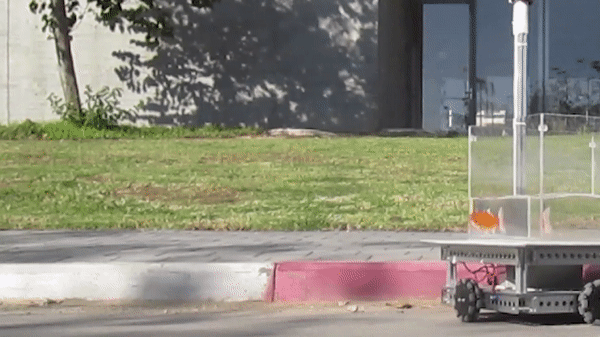Wild video shows goldfish 'driving' a water-filled car in weird experiment
Fish may not need bicycles, but they seem to like cars.

Fish may not need bicycles, but they seem to like cars.
A supremely weird new video shows a goldfish driving a water-filled, motorized "car" from one end of a room to another, bobbing and weaving to avoid obstacles along the way. Scientists performed the odd experiment to better understand how goldfish navigate terrestrial environments.
In the wild, goldfish and many other species must navigate to find food or shelter for survival. But it is not always clear how these animals learn to navigate a space and, for fish, whether the brain networks that allow them to navigate a coral reef would be of any use on land.
What better way to explore animal navigation in a foreign environment than to literally take a fish out of water?
"Because fish are notorious for not surviving out of water, we had to build this inverted submarine," said Shachar Givon, a doctoral student at Ben-Gurion University of the Negev in Israel. The submarine, or fish operated vehicle (FOV), was essentially a plastic aquarium mounted on a small platform with wheels. A single goldfish in the aquarium could pilot the vehicle simply by swimming.
Related: 10 of the weirdest experiments of 2021
Getting goldfish to drive such cars is, surprisingly, not new. In 2014, a group called Studio diip developed a similar goldfish mobile, but at the time, it was more of a software demonstration than an exploration of fundamental animal behaviors.
Get the world’s most fascinating discoveries delivered straight to your inbox.
But Givon and her colleagues at Ben-Gurion University of the Negev Matan Samina, Ohad Ben-Shahar and Ronen Segev demonstrated that the fish car is more than a fun novelty. They just had to give the fish somewhere to go.
In the study, six goldfish were trained to pilot the FOV. "Training was the easiest part," Givon said. "I simply put it in a situation where it learns what is going on around it."
At first, each fish's movement was erratic as it swam from one side to the other in its roving reservoir. Eventually, Givon said, the fish began to connect the dots, and its movements became calmer and more deliberate.
"If you put a person in a car for the first time without telling them anything about it, they will realize that what they do with the steering wheel matters with which way the car goes," Givon told Live Science. "The same goes for the fish — it realizes this slowly, but all on its own."
Getting the fish to make the vehicle move is one thing; learning whether it can make sense of the environment around the vehicle is another matter entirely.
In the beginning, the trials were simple. The vehicle started in the center of a room, and Givon and her colleagues placed a pink cardboard square on the floor, away from the vehicle. If the vehicle moved across this pink square, the fish received a treat.
After a few days of this, the fish car went from meandering around the room to darting directly at the target. Once this task became trivial for the fish, Givon placed obstacles and fake targets in the arena in an effort to force the fish to adjust to changes in its environment. After getting used to these extra features, the fish were barely fazed by the obstacles.
According to Givon, this research suggests that goldfish can learn to navigate completely unfamiliar environments, not just specific ones, like a coral reef.
In the future, Givon would like to explore how fish learn to navigate longer routes in less-contrived situations. "We want the fish to go outside and navigate a natural human environment," Givon said. This could potentially allow the researchers to observe how the fish might make decisions in more dynamic unfamiliar environments.
"We're looking forward to fish [cars] crawling all over campus," Givon said.
This study was published online Jan. 4 in the journal Behavioural Brain Research.
Originally published on Live Science.

Cameron Duke is a contributing writer for Live Science who mainly covers life sciences. He also writes for New Scientist as well as MinuteEarth and Discovery's Curiosity Daily Podcast. He holds a master's degree in animal behavior from Western Carolina University and is an adjunct instructor at the University of Northern Colorado, teaching biology.


